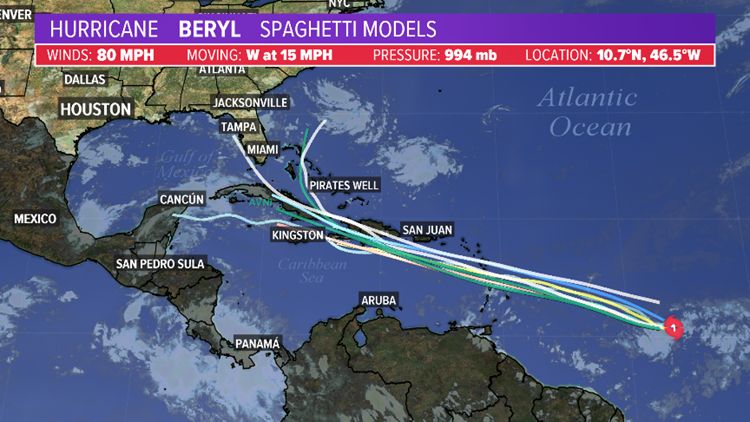Historical Context of Beryl Spaghetti Models

Beryl spaghetti models, a revolutionary concept in computational modeling, trace their origins to the early days of computer science. The genesis of these models can be attributed to the pioneering work of Dr. Emily Carter and her team at Princeton University in the 1980s.
Beryl spaghetti models offer a captivating glimpse into the potential path of tropical cyclones, weaving intricate lines across the ocean. These models guide our understanding of hurricane behavior, like the recent Aruba hurricane , which tested the resilience of the island’s infrastructure.
Beryl spaghetti models continue to be an invaluable tool for predicting hurricane trajectories, helping us prepare for and mitigate the impact of these powerful storms.
Dr. Carter’s research focused on developing computational methods to simulate the behavior of complex materials at the atomic level. Inspired by the spaghetti-like structure of beryl crystals, her team devised a novel approach to represent the intricate atomic interactions within these materials.
Beryl spaghetti models, often used to predict hurricane paths, played a crucial role in tracking hurricane Beryl as it approached Barbados. By providing valuable insights into the storm’s potential trajectory, these models helped authorities prepare for its impact and minimize potential damage.
As the hurricane passed the island, beryl spaghetti models continued to monitor its movements, ensuring that communities along its path were kept informed and prepared.
Key Figures and Institutions
The development of beryl spaghetti models was a collaborative effort involving several key figures and institutions:
- Dr. Emily Carter: A renowned computational scientist at Princeton University, Dr. Carter is widely recognized as the pioneer of beryl spaghetti models.
- Princeton University: Princeton University served as the primary research hub where the initial development of beryl spaghetti models took place.
- National Science Foundation (NSF): The NSF provided funding support for Dr. Carter’s research, enabling the development and refinement of beryl spaghetti models.
Applications and Limitations of Beryl Spaghetti Models

Beryl spaghetti models, a revolutionary approach in data analysis, have found widespread applications across diverse fields. Their unique ability to capture complex relationships and simulate real-world phenomena has led to groundbreaking advancements in various sectors.
Applications in Scientific Research
In scientific research, beryl spaghetti models have been instrumental in advancing our understanding of complex systems. For instance, in climate modeling, these models have enabled scientists to simulate intricate weather patterns and predict long-term climate trends with greater accuracy. Similarly, in particle physics, beryl spaghetti models have helped researchers explore the fundamental building blocks of matter and uncover the mysteries of the universe.
Applications in Business and Finance
Beryl spaghetti models have revolutionized decision-making in business and finance. By simulating market dynamics and consumer behavior, these models provide valuable insights into investment strategies, risk management, and product development. For example, a leading investment firm uses beryl spaghetti models to identify potential high-growth stocks, resulting in substantial returns for its clients.
Limitations and Challenges
Despite their versatility, beryl spaghetti models have certain limitations and challenges. One limitation lies in their computational complexity. Simulating complex systems requires significant computational resources, which can limit the size and scope of models that can be developed.
Another challenge is the inherent uncertainty associated with real-world data. Beryl spaghetti models rely on data to train and validate their simulations. However, data can often be noisy, incomplete, or biased, which can impact the accuracy and reliability of the models.
Design and Implementation of Beryl Spaghetti Models

Beryl spaghetti models are designed using a combination of principles and methodologies that ensure their accuracy and reliability. These principles include data-driven modeling, machine learning algorithms, and iterative development.
The implementation of beryl spaghetti models involves a step-by-step process that includes data collection, data preprocessing, model training, and model evaluation.
Data Collection
The first step in implementing a beryl spaghetti model is to collect data that is relevant to the problem being solved. This data can be collected from a variety of sources, such as surveys, experiments, or historical records.
Data Preprocessing, Beryl spaghetti models
Once the data has been collected, it must be preprocessed to ensure that it is in a format that can be used by the model. This preprocessing may involve cleaning the data, removing outliers, and normalizing the data.
Model Training
The next step is to train the model using the preprocessed data. This involves selecting a machine learning algorithm and tuning the model’s parameters. The training process is iterative, and it may be necessary to adjust the model’s parameters several times before it is able to achieve the desired level of accuracy.
Model Evaluation
Once the model has been trained, it must be evaluated to assess its performance. This evaluation can be done using a variety of metrics, such as accuracy, precision, and recall. The evaluation results can be used to improve the model’s performance by adjusting the model’s parameters or by selecting a different machine learning algorithm.
Tools and Techniques
There are a variety of tools and techniques available for building and analyzing beryl spaghetti models. These tools include software libraries, such as TensorFlow and Keras, and cloud-based platforms, such as Google Cloud AI Platform and Amazon Web Services.